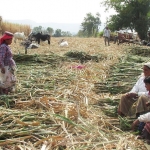Malaysia: Consumer Groups Press for Labelling of GE Food
PENANG, Malaysia -- Buoyed by a string of recent campaign successes, consumer groups around the world are now demanding mandatory labelling of genetically modified (GM) food as they mark World Consumer Rights Day on Mar 15, reflecting growing concern about the unregulated production and trade of GM food crops.
Mandatory labelling, insist the groups, would enable consumers to make
informed choices a basic consumer right. It would also
protect their right to safety by allowing any subsequent health problems to
be properly identified and traced back to source.
Genetic engineering takes the DNA of genes from one organism (animals,
plants, bacteria) and inserts them into a completely different organism (e.g. food crops) to transfer a desired trait. Plants are genetically modified to improve resistance to pests and weed-killers. But activists worry about the long-term effects of tampering with nature.
Creating herbicide-tolerant crops is like ''giving one plant a radiation
suit, then dropping a small nuclear device to wipe out all other plant life in the area, as well as the animal life that depends on it, along with any hope of sustainable agriculture,'' wrote Andrew Simms of Christian Aid.
Consumers are reacting with growing concern, says Julian Edwards, the
director general of Consumers International, a federation of over 250 consumers' organisations in 111 countries.
Foremost is the fear that GM crops might be dangerous to eat in some way,
he points out, saying that consumers face risks from the unintended effects of GM foods.
Edwards was speaking here at the launch last week of a CI campaign kit to
heighten awareness of consumer rights using the
theme 'Our Food, Whose Choice? Consumers Take Action on GM Foods'.
Genetic modification can transfer allergies from foods that people know
they are allergic to to foods they think are safe. About 2
percent of adults and 8 percent of children have true food allergies and
about one quarter have reacted adversely to some type of
food.
''Failure to label GM foods,'' says the CI campaign kit, ''would mean that
people with allergies have no way of knowing whether
they are eating potentially risky foods or, in the event of problems, what
ingredient provoked the reaction.''
Activists also highlight the uncertain long-term effects on nutrition and
health posed by GM foods. They point to the use of
antibiotic- resistant genes as ''markers'' (to track the gene carrying the
trait being transferred) in GM crops, which, they say, could
add to the problem of antibiotic resistance. Genetic manipulation, argue
the activists, could also increase levels of natural plant
toxins in foods or create entirely new toxins in unexpected ways.
''The testing has not been as rigorous as it is with medicine,'' says
physician Nadine Gusman, a World Health Organisation
consultant. Gusman wondered who was carrying out the research. Were they
the same firms developing the technology, she asks.
The other major risk, notes Edward, is the impact GM foods will have on the
environment: ''Do they support sustainable
agriculture in the long run?''
Critics say genes from GM crops could contaminate wild plants, which could
then become resistant or toxic to certain plant pests.
The wind, birds, and insects could carry pollen from GM plants and once
released may cause permanent gene pollution. Crops
engineered to resist herbicide and pesticides may pass their traits on to
their wild relatives and create pesticide-and
herbicide-resistant super-weeds, they say.
GM organisms also threaten to diminish biological diversity, say the
activists. The cultivation of GM organisms, they add, could
lead to the wiping out of weeds and insects. If that happens, the species
that depend on them will also suffer.
There is also the question of seed ownership by big firms through patenting
and terminator technology. ''Farmers in the South are
angry because they don't feel that anyone should own their seeds,'' says
Jennife r Mourin, the Safe Food Campaign Coordinator
of the Pesticide Action Network's Asia-Pacific office in Penang.
The main commercially cultivated GM foods are soya, maize, rape seed
(canola), potatoes and tomatoes. GM soya is present in
about 60 percent of all soy derivatives, including vegetable oils, soy
flour, lecithin and soy protein. GM corn can be found in 50
percent of all corn products and derivatives, such as corn starch, corn
flour and corn syrup.
Over 90 percent of these processed foods are excluded from European Union
labelling norms, the most stringent in the world.
Other GM foods expected soon include rice, sugar, and beets. Animal feed is
the principal market for GM crops. Some 98
percent of global transgenic crop acreage is accounted for by just three
countries: the United States, Canada, and Argentina. The
US has by far the largest acreage at 20.5 million hectares or 74 percent of
the GM fields as of 1998.
The Rio Declaration of the 1992 Earth Summit stated that governments have
to take a ''better safe than sorry'' approach to
potential environmental and health risks. This means that the burden of
proof for a product's long-term safety falls on its producer.
According to the Rural Advancement Foundation International (RAFI) in
Canada, the top five Gene Giants account for nearly
two thirds of the global pesticide market, about a quarter of the
commercial seed market, and virtually all the GM seed market.
The five are AstaZeneca, DuPont, Monsanto, Novartis and Aventis. Monsanto
alone controls nearly 90 percent of the GM seed
market in the U.S., where farmers plant roughly half of their corn, cotton
and soyfields with GM crops.
The biotech industry and many regulatory agencies argue that the
composition of GM food is not chemically different from
conventional ones in ways that could jeopardise their safety or nutritional
value. Using this concept of ''substantial equivalence'',
they argue that GM foods require no special safety testing or labelling.
''This is being strongly resisted by us and other national governments,''
says Edwards.
Some activist groups would prefer an outright ban on GM foods, saying that
labelling would be meaningless for illiterate people,
especially in developing countries.
Although its backers say GM foods are the answer to world hunger and can
produce more nutritious food, critics feel otherwise.
''Are the big gains promised actually there?'' asks Mourin. With GM crops,
Mourin argues that pesticide use will actually go up
with disastrous impact for consumers and the environment.
Consumer groups are fighting back. In a David vs Goliath battle in Brazil,
the 'Instituto de Defesa do Consumidor' (IDEC) and its
allies, using a campaign slogan 'GM Foods: Don't Swallow that Stuff',
stopped the commercial planting of GM seeds in a country
where 25 percent of the world 's soya is grown. The federal court ruled in
June 1999 that Monsanto had to present an
environmental impact assessment before any GM soya could be planted and
sold commercially.
Although some groups want a total ban on GM foods, most consumer groups
recognise the strategic value of pressing for
mandatory labelling. ''Labelling is the key issue,'' conceded a
spokesperson for a Monsanto subsidiary to the press. ''If you put a
label on genetically engineered food, you might as well put a skull and
crossbones on it.''
- 181 Food and Agriculture



